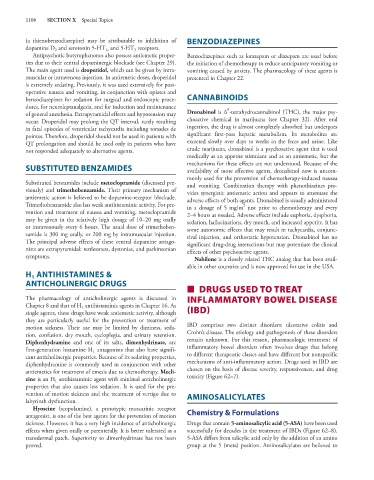Page 1120 - Basic _ Clinical Pharmacology ( PDFDrive )
P. 1120
1106 SECTION X Special Topics
(a thienobenzodiazepine) may be attributable to inhibition of BENZODIAZEPINES
dopamine D and serotonin 5-HT and 5-HT receptors.
3
1c
2
Antipsychotic butyrophenones also possess antiemetic proper- Benzodiazepines such as lorazepam or diazepam are used before
ties due to their central dopaminergic blockade (see Chapter 29). the initiation of chemotherapy to reduce anticipatory vomiting or
The main agent used is droperidol, which can be given by intra- vomiting caused by anxiety. The pharmacology of these agents is
muscular or intravenous injection. In antiemetic doses, droperidol presented in Chapter 22.
is extremely sedating. Previously, it was used extensively for post-
operative nausea and vomiting, in conjunction with opiates and
benzodiazepines for sedation for surgical and endoscopic proce- CANNABINOIDS
dures, for neuroleptanalgesia, and for induction and maintenance 9
of general anesthesia. Extrapyramidal effects and hypotension may Dronabinol is Δ -tetrahydrocannabinol (THC), the major psy-
occur. Droperidol may prolong the QT interval, rarely resulting choactive chemical in marijuana (see Chapter 32). After oral
in fatal episodes of ventricular tachycardia including torsades de ingestion, the drug is almost completely absorbed but undergoes
pointes. Therefore, droperidol should not be used in patients with significant first-pass hepatic metabolism. Its metabolites are
QT prolongation and should be used only in patients who have excreted slowly over days to weeks in the feces and urine. Like
not responded adequately to alternative agents. crude marijuana, dronabinol is a psychoactive agent that is used
medically as an appetite stimulant and as an antiemetic, but the
SUBSTITUTED BENZAMIDES mechanisms for these effects are not understood. Because of the
availability of more effective agents, dronabinol now is uncom-
monly used for the prevention of chemotherapy-induced nausea
Substituted benzamides include metoclopramide (discussed pre- and vomiting. Combination therapy with phenothiazines pro-
viously) and trimethobenzamide. Their primary mechanism of vides synergistic antiemetic action and appears to attenuate the
antiemetic action is believed to be dopamine-receptor blockade. adverse effects of both agents. Dronabinol is usually administered
Trimethobenzamide also has weak antihistaminic activity. For pre- in a dosage of 5 mg/m just prior to chemotherapy and every
2
vention and treatment of nausea and vomiting, metoclopramide 2–4 hours as needed. Adverse effects include euphoria, dysphoria,
may be given in the relatively high dosage of 10–20 mg orally sedation, hallucinations, dry mouth, and increased appetite. It has
or intravenously every 6 hours. The usual dose of trimethoben- some autonomic effects that may result in tachycardia, conjunc-
zamide is 300 mg orally, or 200 mg by intramuscular injection. tival injection, and orthostatic hypotension. Dronabinol has no
The principal adverse effects of these central dopamine antago- significant drug-drug interactions but may potentiate the clinical
nists are extrapyramidal: restlessness, dystonias, and parkinsonian effects of other psychoactive agents.
symptoms.
Nabilone is a closely related THC analog that has been avail-
able in other countries and is now approved for use in the USA.
H ANTIHISTAMINES &
1
ANTICHOLINERGIC DRUGS
■ DRUGS USED TO TREAT
The pharmacology of anticholinergic agents is discussed in INFLAMMATORY BOWEL DISEASE
Chapter 8 and that of H antihistaminic agents in Chapter 16. As
1
single agents, these drugs have weak antiemetic activity, although (IBD)
they are particularly useful for the prevention or treatment of
motion sickness. Their use may be limited by dizziness, seda- IBD comprises two distinct disorders: ulcerative colitis and
tion, confusion, dry mouth, cycloplegia, and urinary retention. Crohn’s disease. The etiology and pathogenesis of these disorders
Diphenhydramine and one of its salts, dimenhydrinate, are remain unknown. For this reason, pharmacologic treatment of
first-generation histamine H antagonists that also have signifi- inflammatory bowel disorders often involves drugs that belong
1
cant anticholinergic properties. Because of its sedating properties, to different therapeutic classes and have different but nonspecific
diphenhydramine is commonly used in conjunction with other mechanisms of anti-inflammatory action. Drugs used in IBD are
antiemetics for treatment of emesis due to chemotherapy. Mecli- chosen on the basis of disease severity, responsiveness, and drug
zine is an H antihistaminic agent with minimal anticholinergic toxicity (Figure 62–7).
1
properties that also causes less sedation. It is used for the pre-
vention of motion sickness and the treatment of vertigo due to AMINOSALICYLATES
labyrinth dysfunction.
Hyoscine (scopolamine), a prototypic muscarinic receptor
antagonist, is one of the best agents for the prevention of motion Chemistry & Formulations
sickness. However, it has a very high incidence of anticholinergic Drugs that contain 5-aminosalicylic acid (5-ASA) have been used
effects when given orally or parenterally. It is better tolerated as a successfully for decades in the treatment of IBDs (Figure 62–8).
transdermal patch. Superiority to dimenhydrinate has not been 5-ASA differs from salicylic acid only by the addition of an amino
proved. group at the 5 (meta) position. Aminosalicylates are believed to

